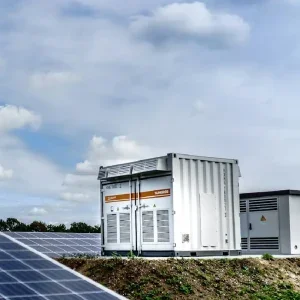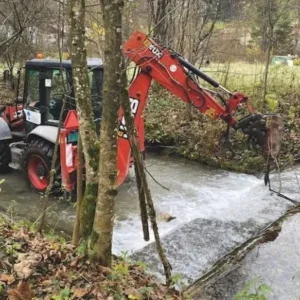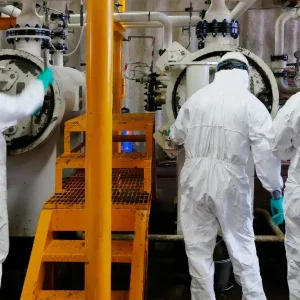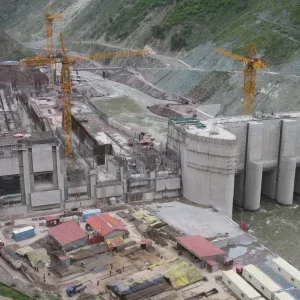With a 12 per cent increase in power input and a 6 per cent reduction in specific fuel consumption, Rolls-Royce has launched the latest version of its industrial RB211 aeroderivatve gas turbine system for power generation.
The industrial RB211-24G upgrade, which is to be released to the market in 1999, will have a launch base load output rating of 30.78 MW compared with the 27 MW of the current model, and a thermal efficiency of 38.9 per cent compared with the 36 per cent of the former model at both 50 Hz and 60 Hz outputs.
This is a leap ahead in performance, achieved largely through improved compressor and power turbine aerodynamics, and a very small increase in compression ratio and mass flow. The pressure ratio has been increased from 20:1 to 20.8:1, which is still much lower than the 35:1 used for the industrial Trent. A relatively small increase in combustion temperature of about 20°C now brings the RB211to a higher figure than the 1525°K of the industrial Trent. This is offset by an increase in exhaust temperature which results in a smaller working temperature difference. Although this may sound as if the designers are getting something for nothing, there is still, allegedly, built-in scope for further development.
Prime mover design
The RB211 has been progressively developed over a period of twenty years. The first industrial RB211 entered service in the late 1970s during the Middle East oil crises. The latest upgrade incorporates advanced technology from the aircraft propulsion versions including the new high thrust BR700 and Trent engines.
The two shaft machine drives a 4-pole alternator via a geared high speed power turbine of new design. For the 24G upgrade, the two spool gas generator has fewer stages in the IP compressor, but because of the improved blade and gas path aerodynamics increases in mass flow and HP compressor efficiency have been achieved. Higher duty materials have been used for the IP turbine blades and a new RT61 power turbine has been developed.
IP Compressor: The IP compressor has a single variable inlet guide vane stage with RVDT control and seven stages in all, two fewer than the earlier models. Extensive three dimensional flow analysis and blade profile improvements with a slight increase in compression ratio from the 20:1 of the present model have resulted in the increased mass flow and augmented performance.
HP compressor:Incorporating the latest aircraft engine compressor design developments from the Trent 800 system, improved aerodynamics and component durability have added substantially to gas generator performance.
HP turbine: In the five stage high pressure turbine, blades are now made from single crystal CMSX4 material using technology from the latest high thrust aircraft engine design.
Combustion system: The engine can run on gas or liquid fuels, or a combination of both with full on-load changeover capability. A full range of fuel system options is available:
Gas, dual fuel with water injection for NOx suppression
Gas, DLE dry low emissions well proven on the industrial Trent and RB211 are guaranteed to give less than 25 ppmv NOx and less than 25 ppmv CO.
A liquid fuel auxiliary system with water injection for gas burning systems with DLE dry low emissions combustion.
The last option of water injected liquid fuel auxiliary capability was accepted as being:
Lowest capital cost
Lowest ownership cost/ highest integrity design for power plant
The design which gives maximum achieved generation output with lowest maintenance costs over the project life.
The Rolls-Royce DLE burner design is a series staged, premix – lean burn arrangement with radial swirl inlet to the primary zone to achieve adequate flame length. A pilot diffusion flame is still a key requirement to reduce the number of necessary stages. A two stage burner is now used in the industrial RB211 and industrial Trent, but on the test bed and in the laboratory, three stage versions have been shown to achieve single figure NOx levels. A series of nine tubular combusters configured radially gives some 80 per cent increase in combustor volume over the pre 1994 annular design.
Rolls-Royce brought the first DLE aeroderivative gas turbine into service in December 1994 when an industrial RB211 began operations at the Pacific Gas Transmission Co. pumping station at Starbuck in Washington State,and two more installations followed in Eastport and Athol in Idaho. The upgrade will be available with either the DLE or conventional diffusion combustion systems.
Power turbine: RT61 power turbine efficiency enhancements are largely due to the increased aerodynamic stage loading in the three stage configuration and the new aerodynamics of the airfoil design. As with the high pressure turbine, single crystal CMSX4 blades are used.
The innovative centre frame structure design makes for close clearance control, and the three -fin tip seal design and new rim seal configuration make for maximum cooling air effectiveness. A revised exit air flow path design has resulted in improved, low loss exhaust system performance.
The combination of higher compression ratio and lower working temperature range at higher temperature levels makes for reduced variation in performance with changing ambient temperature. Figure 5 indicates the levels of temperature dependency.
Packaged generating set
A compact, space saving, industrial RB211 generating set, prepackaged and tested can be accommodated on a site area of less than 250 m2 for a 30 MW simple cycle plant. The unit comprises five main packages, of modular construction for ease of transportation, handling at the site and assembly:
Air intake package – which houses the air cleaning, silencing, chilling and general aerodynamic preparation of the combustion air entering the compressor intake.
Gas turbine package – providing thermal and acoustic insulation of the gas generator, the power turbine and its ancillary systems in a weatherproof enclosure.
Generator package – which integrates the generator with its lubrication, excitation and cooling systems.
Exhaust package – for silencing and discharge of the exhaust air away from the plant for systems in which exhaust heat is not to be recovered.
Accessory package – housing the fuel and lubrication supply and some other auxiliary systems.
The whole assembly takes up very little space compared with the heavy industrial alternative for the same power output.
The low mechanical and thermal inertia of the aeroderivative unit means that it can reach full output in a very much shorter timescale, burning less fuel in the process. These are major benefits for a mid range or peaking plant which operates intermittently with frequent stops and starts. These advantages also make high efficiency aeroderivative turbines useful for spinning reserve and frequency regulation duties.
Combined cycle performance
With an exhaust gas temperature of some 510°C, 23°C higher than the present model, and mass flow of over 92 kg/s, the combined cycle performance specification is remarkably good for a small gas turbine.
With a simple single pressure exhaust heat recovery boiler and Rolls-Royce’s newly designed radial exhaust steam turbine in a packaged single train unit, a combined cycle output of 41 MWe is achieved at a thermal efficiency of 49 per cent.
This configuration is well suited to the new market for mid-merit multi-start distributed generation applications resulting from liberalisation of the electricity supply industries around the world. Cogeneration applications are equally impressive.
Maintenance
Maximum maintenance flexibility has been retained for mixed fleet operators by ensuring full interchangeability including:
Gas generator upgrades can be fitted to existing RT56 and RT62 power turbines
Existing gas generators can be fitted to the new RT61 power turbine
Modularity in the design of all of the industrial Trent and RB211 gas generators results in considerable reductions in unit down-time, and this concept has now been extended to the new three stage power turbine. The power turbine also incorporates the vertically split bearing case design for easy accessibility and maintenance. Easy replacement of the turbine hot section is also a feature of the engine design.
The HP turbine speed probe has now been revised for improved monitoring and the high pressure compressor borescope port has been relocated.
The gas generator comprises five modules which can be removed or replaced individually. A new or leased module can be fitted while the original is sent for repair, so minimising downtime and reducing maintenance costs. On-site module exchange and rebuild capability results in lower project risk as well as higher availability and lower spare parts inventories. It is claimed that a complete gas generator exchange can be done by a team of three personnel inside twelve hours, even on remote sites.
Maintainability is, as ever, of the highest priority, and a full range of service programmes from scheduled through to fully comprehensive contracts are offered as well as the lease engine programme. Rolls-Royce say that remote monitoring of all of their machines is now routine.






